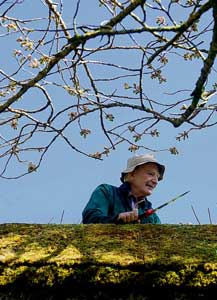

The Royal Horticultural Society of Ireland has signed a lease to take over the management of the walled garden at Russborough House, Co Wicklow, writes FIONNUALA FALLON.
IT’S SOMEWHAT astonishing to think that 208 years have passed since the celebrated English botanist Sir Joseph Banks and the horticulturist John Wedgwood met up with five other like-minded friends in Hatchard’s bookshop in Piccadilly, London, to found the now world-famous Royal Horticultural Society (rhs.org.uk).
Just 12 years later, a very similar organisation was founded here in Ireland, when in 1816 a group of Dublin gardeners met in the appropriately-titled Rose Tavern in Donnybrook to discuss their concerns that “the art of gardening was falling away and rapidly declining”. The result was the establishment of the Horticultural Society of Ireland, later known as the RHSI (rhsi.ie).
But while the UK-based RHS went on to establish its own flagship gardens at Wisley in Surrey, Rosemoor in Devon, Hyde Hall in Essex and, most recently, Harlow Carr in North Yorkshire, it’s only now – at the grand old age of 196 – that the RHSI has finally followed suit, in what its president, Robert Myerscough, has recently described as “a long-held wish fulfilled.” For much to the delight of its 1,000-plus members as well as that of interested gardeners everywhere, the RHSI announced last October that it had signed a lease with the trustees of the Alfred Beit Foundation to take over the management of the three-and-a-half acre walled garden at Russborough House, just outside Blessington in Co Wicklow.
Situated some distance away from the Palladian mansion that the architectural historian Desmond Guinness has described as “the jewel in the crown of all Richard Castle’s houses”, this large, south-facing walled garden was originally laid out some time in the early 1800s but had fallen into quite poor repair in recent years. That won’t be the case for very much longer, because the society’s ambitious plan is to develop the RHSI Garden Russborough (as it’s to be known) both as an amenity, and as an educational tool that will foster practical gardening skills while promoting Irish horticulture.
Its envisaged redesign includes not only a separate rose garden, a flower-arrangers’ garden, an environmental garden, a large, intricately planted, double herbaceous border, an Irish garden devoted exclusively to native cultivars and an extensive fruit and vegetable garden, but also the restoration of the existing curvilinear glasshouse and the installation of a new dome-roofed, double-winged glasshouse, as well as repairs to both the original Victorian boiler-house and the garden’s historic stone walls.
The aim, says Myerscough, is to have it completed by 2016, the society’s bicentenary year. The catch, as always, is a lack of funds. “We’re looking at something in the region of €750,000 to complete the project,” says RHSI committee member and project co-ordinator John Quin, when I meet with him, Robert Myerscough and their fellow committee member Anne James in the walled garden. “The RHSI is actively seeking funding for the restoration and also welcomes any donations or offers of help, it doesn’t presently have any revenue stream in place for the project. So, for the moment, it’s relying on its own capital and the goodwill of its members,
many of whom have been working on a voluntary basis in the garden since last autumn. But we’ve been lucky in that the response to our appeal for volunteers has been absolutely amazing. Since last October, we’ve had 10, 15, even 20 people coming along every second Wednesday and Saturday to help. What’s also fantastic is the huge variety of skills and range of experience that they’re bringing to the project, while we can also rely on the expertise of committee members like Anne [a professional horticulturist] and Robert [a garden designer].”
Surely one of the oldest volunteers is the astonishingly spry 83-year-old Dick Mallet, whom I spot as he perches at the very top of a very tall ladder, skilfully pruning the rather overgrown espalier apple and pear trees that grow along the walled garden’s old stone walls. He has, he tells me, been a keen gardener since his very early childhood.
“My parents had a large garden in Monkstown [Co Dublin] which they employed a gardener to look after. From when I was just a little boy, no more than four or five years old, he used to push me around in the wheelbarrow and teach me about the different plants and how to look after them. It was the beginning of a life-long interest in gardening,” says Mallet, who has been a member of the RHSI for more than 40 years.
“That sort of learning experience is central to what the society and this garden are about – the plan is that Russborough will soon become the place where people of all ages come to learn about gardening,” says James.
In the meantime, the hard work of restoration continues. “One regular volunteer admitted to me recently that her own garden was beginning to suffer as a result of the amount of time she was giving to the garden at Russborough,” says Myerscough. “But then she added that she has hugely enjoyed being a member of the RHSI for over 30 years. Now she felt that it was time to give something back.”




